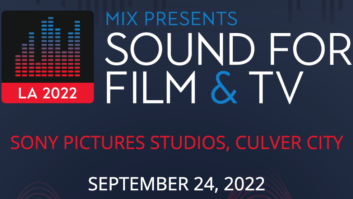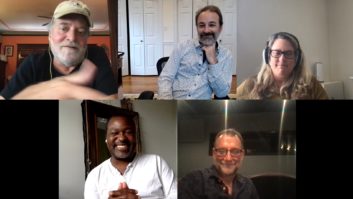Incredible Music and Audio Design Add to the Experience of this Expository Film
Science Fiction films are known for exploiting twisted sounds to enhance the drama and viewer experience–whether it be the manipulation of odd animal noises in horror thrillers, or even the absence of audio in futuristic films like Stanley Kubrick’s 2001: A Space Oddessy. The music and sound team for the latest rendition of Georg Buchner’s oft-adapted play “Woyzeck” found themselves with heightened challenges when creating an auditory motif for director Craig Erpelding’s short film, The Woyzeck Project.
Erpelding went to his sound team with a mission to create a full audio environment for the film which takes place in a future America where the NYSE fully collapses and China takes over. The aim was to mesh gritty industrial music with a separate sound design that nods to
the growing mental illness the main character exhibits due to being the test subject of mind-controlling drugs. Easier said than done, especially in a short film.
“With short films sometimes you tend to want to throw more ideas in, instead of relying on one piece of music,” says Paul Wiley, who created all of the original music for the film.
But, Erpelding pointed to films like Aranofsky’s The Fountain as an example of filling the movie full of music, from beginning to end. Therefore, Wiley set off on his quest to create one, 25-minute musical composition to lay under the entire picture.

“I wanted to enhance the film without ever taking it over,” says Wiley of his charge. “The most important thing was to make a piece that would dynamically change a lot without being totally apparent. Something that would be interesting to listen all the way through, even without the film.”
And, indeed the music is stands on its own. To create the piece, Wiley viewed the rough cut multiple times with just the spoken dialogue to obtain a flow of the film’s tempo. After that he developed short 20 to 30 second pieces that could serve as reoccurring themes–intentionally keeping them very stark and cold to fit the sterile, futuristic setting of The Woyzeck Project.
“It was all about texture and layering sounds and instruments to enhance the weight or the push,” Wiley says. “Sometimes that meant subtle string lines soaring over the picture, or timpani drums filtered through various pedals. As far as the particular sound design movements in the music–the droning and dissonant pieces–I wanted to make those more chilling and eerie. Basically I used Kubrick films and old Dr. Who episodes as a template.”
Wiley created the music for the film at his home studio using an iMac fitted with Pro Tools–using some native instrument plug-ins to start, then sending the sounds through his own filtering process via a supply of different outboard gear including old school pedals and various rack processors. All-in-all Wiley worked deliberately within the constraints of any deadlines, paying attention to all of the particular details that make the score successful.
“Some sounds that would only appear for 5 or 10 seconds, would get toyed with for 5 hours,” Wiley says. “Knowing that I had a good timeline allowed me to explore that.”
Time was not on the side of the Lead Sound Designer, Joe Marcus, who was brought on very late in the postproduction process, charged with re-editing all of the film’s dialogue, on top of Foley, and other creative sound design processes.
“One thing I’ve learned from doing post for independent productions, is that time and budgetary problems always transform into technical problems,” Marcus says.
And such was the case when he was handed destructively created ProTools files with prior EQ, compression, and reverb processes in place. Marcus had to pull out all the tricks to fix the sound on a mere three week turnaround. But, coming on the project so late, meant that there were other parts of the creative process that he had to hurriedly address.
“I was still trying to figure out the intricacies of the story while developing the sound design,” Marcus says. “But, we had to move forward, and due to scheduling, Jason Toy [Marcus’ sound assistant for the project] and I did all of the Foley in one twelve hour session.”
The sound design team did most of their work at DePaul University’s sound studio using a ProTools HD sound board system with D-command. For Foley, Marcus turned to the Sennheiser MD421 running through a Digidesign PRE 8 channel preamp.
“I like the sound of bigger dynamic microphones for Foley,” Marcus says. “Condensors make the Foley sounds seem unrealistically close, while dynamic microphones add some distance between the audience and the sound.”
Marcus and Toy’s quick work made incredible advancements in the film’s audio and sound effects layers, providing an amazing final result when meshed with Wiley’s music. The complete package makes for almost a “wall of sound” type of audio experience that dramatizes the unique, emotional journey of Franz Woyzeck, the film’s protagonist.
“Emotionally, the movie starts off very flat and then gradually heightens towards the end as Franz loses more and more of his mind. I tried to mimic this idea in the sound design,” Marcus says. “The sound design starts very simple, without any weird noises or anything like that. However, by the end of the movie, the amount of other-worldly sound overpowers the realistic sound in the same way that Franz’s irrationality and general craziness overpowers his sanity.”
In the end, Erpelding felt his original quest was accomplished.
“Paul [Wiley] and Joe [Marcus] definitely took the bull by the horns and got the job done,” Erpelding says. “I can’t say enough for how professionally they handled the challenges I threw at them. The intricate details they put into their work was crucial to fulfilling the film’s vision–they did an amazing job.”
The Woyzeck Project was created on a budget of less than $5,000 and is slated to run the 2011-2012 festival circuit, aiming for a world debut at the 2011 Chicago International Film Festival in October. A teaser for the film can be seen at http://www.imdb.com/title/tt1913179/.
Wiley’s original music for the film can be downloaded at http://egostatic.bandcamp.com./track/the-woyzeck-project-score.







